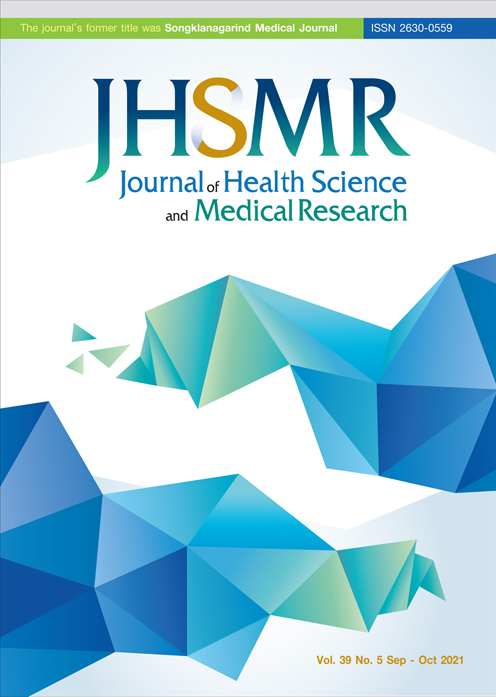Serum Angiopoietin-1/Angiopoietin-2 at 16-18 Weeks of Gestation to Predict Preeclampsia
DOI:
https://doi.org/10.31584/jhsmr.2021793Keywords:
angiogenesis, angiopoietin, prediction, preeclampsia, ratioAbstract
Objective: To determine whether serum angiopoietin-1/angiopoietin-2 ratio can predict preeclampsia in women at 16–18 weeks of gestation, or not.
Material and Methods: This was a prospective observational study that was conducted in pregnant women with gestational age of 16-18 weeks. Serum angiopoietin-1 and angiopoietin-2 levels were acquired. The predictive values of these tests were calculated.
Results: Data from 269 pregnant women were analyzed. Twenty-two cases developed preeclampsia, and five of these cases had early onset preeclampsia. When the angiopoietin-1/angiopoietin-2 ratio was above 6.2, the sensitivity, specificity, positive predictive value and negative predictive values to predict preeclampsia were 50.0%, 72.9%, 14.1% and 94.2%, respectively. When angiopoietin-1 was used to predict preeclampsia, the sensitivity, specificity, positive predictive value and negative predictive values were 59.1%, 65.2%, 13.1% and 94.7%, respectively. When angiopoietin-2 was used to predict preeclampsia, the sensitivity, specificity, positive predictive value and negative predictive values were 63.6%, 50.2%, 10.2% and 93.9%, respectively.
Conclusion: This study demonstrated that serum angiopoietin-1/angiopoietin-2 ratio at 16-18 weeks of gestation was not effective in predicting preeclampsia. However, angiopoietin-2 may be used to predict preeclampsia.
References
Cunningham FG, Lenovo KJ, Bloom SL, Dashe JS, Hoffman BL, Casey BM, et al. Williams obstetrics. 25th ed. New York: McGraw Hill; 2018.
Charnock-Jones DS. Soluble flt-1 and the angiopoietins in the development and regulation of placental vasculature. J Anat 2002;200:607-15.
Kappou D, Sifakis S, Konstantinidou A, Papantoniou N, Spandidos DA. Role of the angiopoietin/Tie system in pregnancy (Review). Exp Ther Med 2015;9:1091-6.
Thurston G. Role of Angiopoietins and Tie receptor tyrosine kinases in angiogenesis and lymphangiogenesis. Cell Tissue Re 2003;314:61-8.
Thomas M, Augustin HG. The role of the Angiopoietins in vascular morphogenesis. Angiogenesis 2009;12:125-37.
Geva E, Ginzinger DG, Zaloudek CJ, Moore DH, Byrne A, Jaffe RB. Human placental vascular development: vasculogenic and angiogenic (branching and nonbranching) transformation is regulated by vascular endothelial growth factor-A, angiopoietin- 1, and angiopoietin-2. J Clin Endocrinol Metab 2002; 87:4213-24.
Nadar SK, Karalis I, Al Yemeni E, Blann AD, Lip GY. Plasma markers of angiogenesis in pregnancy induced hypertension. Thromb Haemost 2005;94:1071-6.
Hirokoshi K, Maeshima Y, Kobayashi K, Matsuura E, Sugiyama H, Yamasaki Y, et al. Increase of serum angiopoietin-2 during pregnancy is suppressed in women with preeclampsia. Am J Hypertens 2005;18:1181-8.
Hirokoshi K, Maeshima Y, Kobayashi K, Matsuura E, Sugiyama H, Yamasaki Y, et al. Elevated serum sFlt-1/Ang-2 ratio in women with preeclampsia. Nephron Clin Pract 2007;106: c43-50.
Vuorela P, Matikainen MT, Kuusela P, Ylikorkala O, Alitalo K, Halmesmaki E. Endothelial tie receptor antigen in maternal and cord blood of healthy and preeclamptic subjects. Obstet Gynecol 1998;92:179-83.
Leinonen E, Wathen KA, Alfthan H, Ylikorkala O, Andersson S, Stenman U, et al. Maternal serum angiopoietin-1 and -2 and tie-2 in early pregnancy ending in preeclampsia or intrauterine growth retardation. J Clin Endocrinol Metab 2010;95:126-33.
Bolin M, Wiberg-Itzel E, Wikstrom AK, Goop M, Larsson A, Olovsson M, et al. Angiopoietin-1/angiopoietin-2 ratio for prediction of preeclampsia. Am J Hypertens 2009;22:891-5.
Puttapitakpong P, Phupong V. Combination of serum angiopoietin- 2 and uterine artery Doppler for prediction of preeclampsia. Hypertens Res 2016;39:95-9.
Schneuer FJ, Roberts CL, Ashton AW, Guilbert C, Tasevski V, Morris JM, et al. Angiopoietin 1 and 2 serum concentrations in first trimester of pregnancy as biomarkers of adverse pregnancy outcomes. Am J Obstet Gynecol 2014;210:345e1-9.
Report of the National High Blood Pressure Education Program Working Group on High Blood Pressure in Pregnancy. Am J Obstet Gynecol 2000;183:S1-22.
Machado JSR, Machado MSR, Bertagnolli TV, Martins LA, Freitas SF, Ovidio PP, et al. Role of plasma PlGF, PDGF-AA, ANG-1, ANG-2, and the ANG-1/ANG-2 ratio as predictors of preeclampsia in a cohort of pregnant women. Pregnancy Hypertens 2019;16:105-11.
Han SY, Jun JK, Lee CH, Park JS, Syn HC. Angiopoietin-2: a promising indicator for the occurrence of severe preeclampsia. Hypertens Pregnancy 2012;31:189-99.
Aksornphusitaphong A, Phupong V. Risk factors of early and late onset pre-eclampsia. J Obstet Gynaecol Res 2013;39:627- 31.
Downloads
Published
How to Cite
Issue
Section
License

This work is licensed under a Creative Commons Attribution-NonCommercial-NoDerivatives 4.0 International License.
























